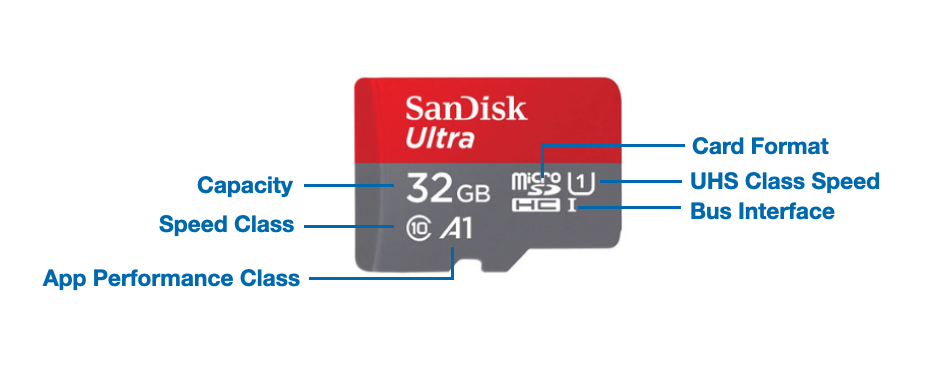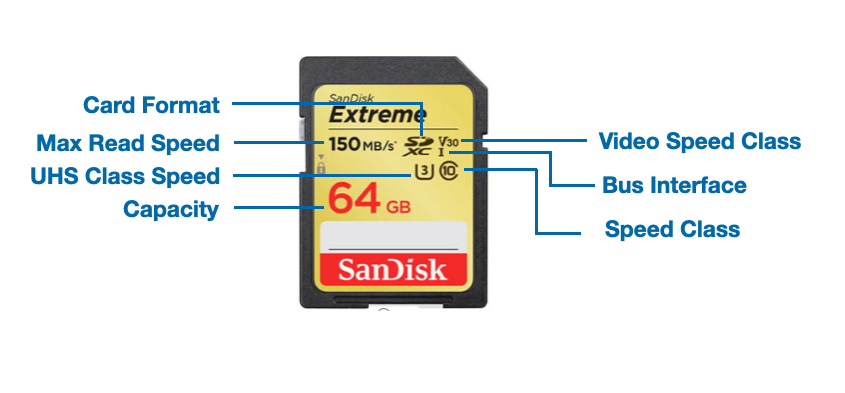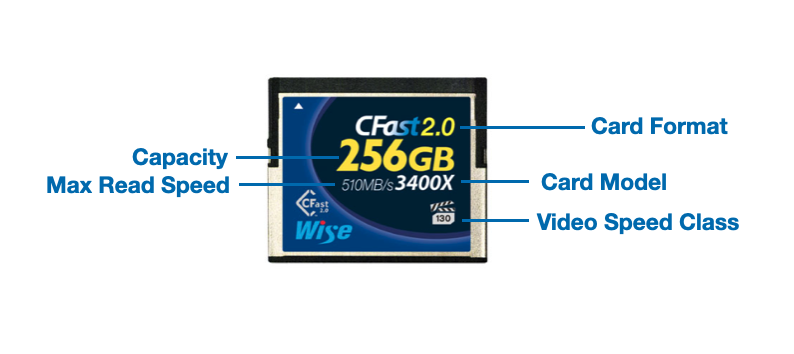Memory Card Buyers Guide
Which memory card do I need?
A memory card is a small storage device that uses nonvolatile flash memory to store data for portable computing devices such as smartphones, tablets and cameras. They may act as the devices sole storage capacity or be an optional feature to expand storage capacity alongside some embedded memory. Memory cards have been around for many years and the formats and sizes have changed and evolved resulting in larger capacity cards combined with a reduction in physical size.

In this guide we’ll look at the common types of memory cards available today, why you should consider them and what they are best used for, so you are sure to make the best decisions when choosing a solution.
Why use memory cards?
Any portable digital device, be it a smartphone or camera must have some kind of memory to store data generated or used by the device - text, photos, music or video. In most cases smartphones and tablets will have internal memory plus a memory card slot so you can expand the memory if required. In the case of cameras, a memory card is likely to be the sole way to store photos and videos. The small form factor of memory cards is ideal for light and portable devices, as the memory card slot takes up little room and the card itself doesn’t protrude from the device like a regular USB flash drive would.


Additionally, as memory cards use NAND chips to store digital files, they are non-volatile, meaning they have no moving parts so they are ideal for devices that are transported a lot. The NAND chips also allow data from the device to be written quickly onto the memory card, so again this make them perfect for battery powered mobile devices.
Memory cards formats
Although all memory cards use NAND chips, much like in most areas of technology there is no one standard card format. Over the years several formats have been developed and these also have multiple generations just to make things nice and complicated. There are currently three main types of cards widely in use today - SD or Secure Digital cards, MicroSD or Micro Secure Digital cards and CF or Compact Flash cards. We’ll take a look at each of these formats below.
Compact Flash (CF) cards were first introduced in 1994 and quickly became the standard card used in many devices. The initial Compact Flash Type I (CF-I) memory cards had dimensions of 42.8 x 36.4 x 3.3mm, however they were limited by the slow Parallel ATA / IDE bus. Compact Flash Type II (CF-II) cards were then developed that were slightly thicker at 5.0mm, and offered higher capacities but little speed benefit over the CF-I cards. To get away from the slow Parallel ATA / IDE bus, a new Compact Flash memory card variant called CFast was invented, which utilised the much faster Serial ATA (SATA) bus and capacities up to 256GB. It is worth noting that although the physical dimensions of CFast cards are very similar to those of CF cards, they are not backwards compatible due to difference types of interfaces. The latest CF standard is CFexpress, introduced in 2016, is a smaller format at 38.5 x 29.8 x 3.8mm in size. It also uses NVMe technology for low latency, much greater speeds and capacities up to 1TB.
SD or Secure Digital cards were introduced in 1999 and are a family of cards with a common size of 24.0 x 32.0 x 2.1mm. The original SD card was limited to 2GB capacity due to file system limitations so it they have been superseded by SDHC - Secure Digital High Capacity - cards that can achieve up to 32GB capacities. With better resolution cameras and higher resolution video content the evolution has continued to SDXC - Secure Digital Extended Capacity - cards theoretically capable of capacities up to 2TB, although the maximum common sizes available are currently about 512GB.
MicroSD cards were developed in 2005 due to the standard SD card size being too big for use in smartphones. They are much smaller than SD cards at just 11.0 x 15.0 x 1.0mm, however, much like SD cards, the initial microSD cards were slow and their capacities were limited to 2GB. Also in the same way the next generation SDHC cards removed these limits and the latest generation of SDXC cards made it possible to make capacities up to 512GB - and with much faster read and write speeds.
Memory card speeds
Although we’ve stated that NAND chips allow the data to be written quickly to the memory card, the interfaces and buses used in the cards do vary and impacts their speed of how they read and write information - and unfortunately, there is no standard way of rating the speed of memory cards across the different types. SD Cards and Micro SD cards are segregated by their bus speed - either High Speed or Ultra High Speed (UHS) - this defines the maximum throughput speed of the card. The below table highlights these bus types and their associated speeds.
| Bus Inteface | Compatible Memory Cards | Maximum Bus Speed |
|---|---|---|
| High Speed | SD, SDHC, SDXC | 25MB/sec |
| UHS-I | SDHC, SDXC | 104MB/sec |
| UHS-II | SDHC, SDXC | 312MB/sec |
| UHS-III | SDHC, SDXC | 624MB/sec |
SD cards and MicroSD cards also denote something called “Speed Class” - this defines minimum sequential writing speed a memory card can provide. Some cards also have “Video Speed Class” specifications, which define minimum sequential write speeds for higher performance cards intended for video use.
| Minimum Sequential Write Speed | Speed Class | UHS Class | Video Speed Class |
|---|---|---|---|
| 2 MB/sec | Class 2 (C2) | ||
| 4 MB/sec | Class 4 (C4) | ||
| 6 MB/sec | Class 6 (C6) | Class 6 (V6) | |
| 10 MB/sec | Class 10 (C10) | Class 1 (U1) | Class 10 (V10) |
| 30 MB/sec | Class 3 (U3) | Class 30 (V30) | |
| 60 MB/sec | Class 60 (V60) | ||
| 90 MB/sec | Class 90 (V90) |
This all sounds, and is, confusing, but the manufacturers of the SD and MicroSD cards denote all these attributes on the card to make it clearer, as show in the diagram below:


Compact Flash cards use a similar system denoting speeds but quoting an Ultra DMA mode or bus speed for later CFast and CFexpress models. These are summarised in the table below.
| Card Type | Ultra DMA Mode | Bus | Maximum Transfer Rate |
|---|---|---|---|
| CF-I / CF-II | Ultra DMA 1 | 25MB/sec | |
| CF-I / CF-II | Ultra DMA 2 | ATA | 33.3MB/sec |
| CF-I / CF-II | Ultra DMA 3 | 44.4MB/sec | |
| CF-I / CF-II | Ultra DMA 4 | Ultra ATA/66 | 66.7MB/sec |
| CF-I / CF-II | Ultra DMA 5 | Ultra ATA/100 | 100MB/sec |
| CF-I / CF-II | Ultra DMA 6 | Ultra ATA/133 | 133MB/sec |
| CF-I / CF-II | Ultra DMA 7 | Ultra ATA/167 | 167MB/sec |
| CFast | SATA-300 | 300MB/sec | |
| CFast | SATA-600 | 600MB/sec | |
| CFexpress | PCIe 3.0 x2 | 1970MB/sec | |
| CFexpress | PCIe 3.0 x4 | 4000MB/sec |
CF cards have no speed class alongside this like SD versions do, so they can be simpler to read, as demonstrated in the diagram below:

Memory card readers
In order to transfer your data, images, music or video files, off your memory card once it has been removed from your device you are going to need a memory card reader. Many PCs and laptops and even printers have memory card readers installed in them - either for a specific type of card - commonly SD or a whole host of cards via multiple slots. It is also possible to buy single slot of multiple slot external cards readers too, that attached to your PC or laptop via USB. Any of these types of readers allows you to insert the card directly and see the contents through the computer or printers file browser and access the data to view it, edit it or print it. There are also adapters available that convert a MicroSD format into the larger SD format for ease of compatibility.




However, it is important to understand that cards with a faster bus speed also require a memory card reader that can support that bus speed, so always check the specification otherwise you may experience compatibility issues.
Choose your memory card
Hopefully you’ve found this guide useful in providing a complete picture as to the considerations and decisions that should go into choosing memory cards for your devices. Click below to see our range of cards available.